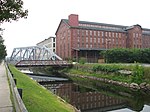North Canal Historic District

The North Canal Historic District of Lawrence, Massachusetts, encompasses the historic industrial heart of the city. It is centered on the North Canal and the Great Stone Dam, which provided the waterpower for its many mill complexes. The canal was listed on the National Register of Historic Places in 1975, while the district was first listed in 1984, and then expanded slightly in 2009.The city of Lawrence was founded by industrialist Abbott Lawrence and the associates of the Essex Company as a model industrial city. In 1845 they company acquired land from then towns of Methuen and Andover and began construction on the North Canal and the Great Stone Dam. The work included dredging and building out of "new land", and effectively created a small island between the Merrimack River and the canal, whose outlet is at the mouth of the Spicket River. Work on these two major features was completed in 1848, and development of the city, which formally incorporated in 1853, proceeded from there. The historic district encompasses, in addition to the canal and the dam, the mill-related buildings on the island and on the north side of the canal, as well as a few buildings that front on Methuen and Union Streets, or the connecting side streets. The 2009 expansion of the district, included a single building, the Morehouse Bakery building at 5-9 Mill Street.
Excerpt from the Wikipedia article North Canal Historic District (License: CC BY-SA 3.0, Authors, Images).North Canal Historic District
Canal Street, Lawrence
Geographical coordinates (GPS) Address Nearby Places Show on map
Geographical coordinates (GPS)
| Latitude | Longitude |
|---|---|
| N 42.705 ° | E -71.158055555556 ° |
Address
242 Canal
Canal Street 242
01840 Lawrence
Massachusetts, United States
Open on Google Maps










